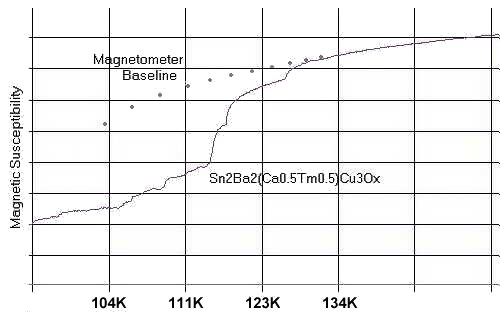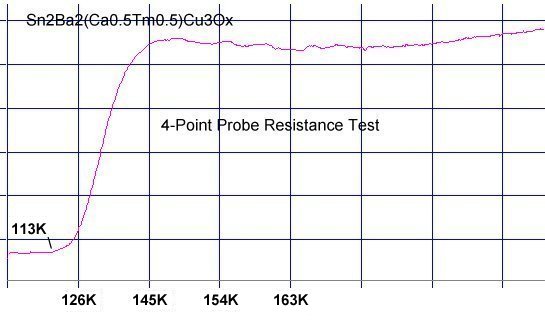
Magnetic susceptibility-v-temperature graph of SnBaCaTm sample, showing 3 distinct Meissner transitions.
Signs of 113-115 K Superconductivity in a
Tin-Thulium Oxycuprate
RESEARCH NOTE: This compound has been found to be strongly hygroscopic.
All tests should be performed immediately after synthesis.
23 February 2005
Superconductors.ORG
UPDATED 17 March 2005
Superconductors.ORG reports Meissner-like behavior
at temperatures near 115 Kelvin and a resistance drop near 113 K in the compound
Sn2Ba2(Ca0.5Tm0.5)Cu3Ox,
suggesting the discovery of a new high-temperature superconductor.

This compound was synthesized as an analog to
Sn2Ba2(Sr0.5Y0.5)Cu3Ox (Aleksandrov, et al, 1989)(1) which
had a reported critical temperature of 86K. The Tc of the Aleksandrov prototype was determined by magnetic
susceptibility tests (H=100 Oe). However, since the Tc of the compound YBaSrCu3O7 is also
near 86K, comparison of Debye patterns was necessary to differentiate the various phases that could have formed. In this
new formulation there are no known superconductors with Tc's near 115K that could have resulted from the precursors.
The magnetic susceptibility plot of this new material (top) shows the onset of
strong diamagnetism (the Meissner transition) at temperatures
comparable to the Hg and Tl oxycuprates, making it an exceptional performer among the 3212 structure types. The
best known of the 3212 superconductors, Pb2Sr2YCu3O8
(Cava, et al, 1989), has a Tc of 70K. The strong signal in the test data suggests a large volume fraction of the
target stoichiometry, with an unknown minority phase producing a diamagnetic step near 127K.
4-point probe resistivity tests confirm a sudden drop in
resistance in the same temperature range as the Meissner transitions, reaching a minimum around 113 Kelvin.
Incorporating tin into the copper-oxides is often
difficult due to tin's small ionic radius. And, thulium ceramics are usually ferrites. Thus, successfully bringing
both tin and thulium into the mix, makes this a very unusual material.
Tm2+ is typically magnetic, with an unpaired and strongly magnetic f electron. Tm3+ is f12 and is also magnetic.
However, if anything, these qualities seem to buttress the higher Hc that Tm-123, for example, has over Y-123.(2)
Additional tests are planned to better characterize this new compound.
Sn2Ba2(Ca0.5Tm0.5)Cu3Ox
appears to have the best ratio of performance-to-toxicity of all the high-temperature superconductors.
(Even BSCCO contains some Pb.)
Attempts to substitute Sr into the Ba site produced an unambiguous
non-superconductor, with strong negative-coefficient thermo-resistive properties in the range of 10x/30K.
Synthesis of the material was by the solid state reaction method. Stoichiometric amounts of the below precursors were mixed, pelletized and sintered for 9-10 hours at 890C. The pellet was then annealed for 10 hours at 500C in flowing O2. Temperature was determined using an
Omega type "T" thermocouple and precision OP77 DC amplifier. The magnetometer employed twin Honeywell SS94A1F
Hall-effect sensors with a tandem sensitivity of 50 mv/Gauss.
Tm2O3 99.99% (Stanford Materials)
CaCO3 99.95% (Alfa Aesar)
SnO 99.9% (Alfa Aesar)
BaCuOx 99.9% (Alfa Aesar)
CuO 99.7% (Alfa Aesar)
- E. Joe Eck
© 2005 Superconductors.ORG
Patent Pending. All rights reserved.
(1) K. S. Aleksandrov, A. D. Valil'ev, Zvegintsev,
S. N. Krivomazov, M. I. Petrov, B. P. Khrustalev
L. V. Kirenskii Institute of Physics, Siberian Branch, Acadamy of Sciences of the USSR (1989).
(2) J. J. Neumeier, et al., "Thulium barium copper oxide: A 90-K superconductor with a potential
1-MG upper critical field," Applied Physics Letters, pp.371-373, vol. 51, no. 5, August 3, 1987.
 BACK to "News" page at Superconductors.ORG
BACK to "News" page at Superconductors.ORG



 BACK to "News" page at Superconductors.ORG
BACK to "News" page at Superconductors.ORG